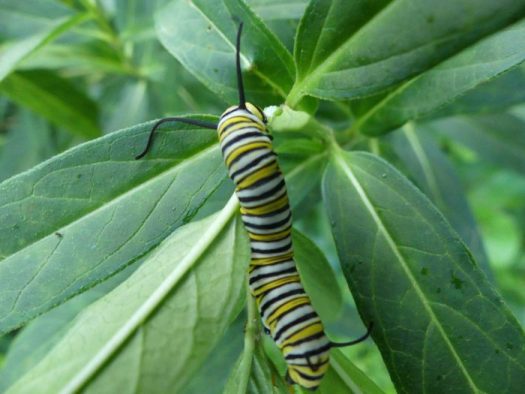
Incredible Journey
Monarchs always amazed me with their unique migration, over 3000 miles in some cases, which seems an impossible task for such a delicate creature. The only butterfly that makes a two-way trip, Monarchs are unique in the animal kingdom. Unable to survive cold winter temperatures, the Monarch has evolved to make this incredible trek to over-winter in warmer climes, such as Mexico and southern California. Using a combination of thermals and air currents, Monarchs sense when it is time to travel and know where to go even though the migrating generation has never been to the distant over-wintering sites.


Monarchs travel along one of three major routes and investigators think that a combination of directional aids such as the magnetic pull of the earth and the position of the sun among others guide them. Monarchs can travel between 50-100 miles a day and it can take up to two months to complete their journey. Traveling only by day, Monarchs roost at night high up in trees to rest before warming up in the sun to continue their journey. A distance of 265 miles in one day is the longest recorded distance of a Monarch! A great website to track the migratory happenings of Monarchs and other animals is Journey North. Citizen Scientists record their observations all over North America to show the movements of animals north in the spring and south in the fall in real-time.
Many teachers include Monarch rearing in their science curriculum in Elementary school but I missed the opportunity in school and wanted to do it myself at home to observe the incredible transformation that these creatures go through. How can such fragile creatures make a 3,000 mile journey to an unknown location and remain there for months, mate and then return to the north to start new progeny?

MonarchTeacherNetwork
Monarch rearing has been on my “must try” list for several years and a two-day Monarch workshop put on by MonarchTeacherNetwork got me motivated and ready to go. Milkweed growing, enclosure instructions, Monarch activities and games, healthy practices of raising, and release ceremonies were all covered in simple, easy to follow directions with added field trips to meadows full of Milkweed and a butterfly house. After the intense two-day workshop, I felt fully prepared to set up my own Monarch raising operation at home.








After gathering some eggs from the meadow walk at Ladew I was ready to begin. Start with the eggs!
Egg Stage

For more information on Monarch Raising, go to Monarch Watch.
The hardest part of raising Monarchs is finding their tiny single creamy-white eggs which are smaller than pin heads. Carrying a portable hand lens on an overcast day makes it a little easier to spot the eggs in the field. If you observe Monarchs swooping in and landing on a Milkweed, there is a good chance that she just laid an egg.

Monarchs tend to lay their eggs singly on the underside of freshly grown leaves of Milkweed, hidden from predators and directly on their food supply for best survival rates.

The butterfly glues the egg on the leaf surface so that it adheres even through a rain storm, but predators find the eggs a tasty treat. The first egg for me was hard to find, but subsequent ones much easier once I knew what to look for. The likelihood of a Monarch surviving the egg and larval (caterpillar) stages is less than 10% in the wild. For great tips on finding eggs, go to How to Hunt, Gather, and Protect Monarch Eggs . This site gives great information on where, when and how to look.

After locating an egg, I note what type of Milkweed they were attached to and remove the leaf or branch and add it to my “nursery enclosure”, a small plastic container with holes poked in the top. Taking only 3 to 5 days to hatch, watch your eggs carefully as the caterpillar can emerge, eat their egg shell and will move on to fresher leaves pretty quickly. When the top of the eggs turns dark, hatching is imminent.

Adding some extra Milkweed leaves will keep the tiny caterpillars busy when they hatch. You could also place tulle or pantyhose over the top to keep any wandering minuscule caterpillars inside. Lining the container with a moistened paper towel makes cleanup of the “frass” or black gooey caterpillar poop easy and adds some moisture to their environment. Once inside the house, air conditioning tends to dry the air out for the caterpillars and a light mist from a spray bottle of water helps. I clean out the plastic container every day as the frass can bring in pathogens that can harm the caterpillars.

After the eggs hatch in about 4 days, the tiny caterpillars are no larger than 1/16 of an inch long. They are delicate and easy to overlook as you handle the Milkweed leaves, so move carefully when you are changing out old for fresh leaves.



So fascinating. I just planted milkweed in my garden this spring.
Very interesting Claire. Thank for the info. I look forward to Part II.
Linda T